1/28 Revell Fokker Dr-1 Triplane, Prototype “F-103” as flown by Werner Voss, September 23rd, 1917
Well it's done... Finally. My original intent was to have the build completed and an article posted here on the Imodeler website by September 23rd, 2017. But Mother Nature with Hurricane Irma, and a few other bumps in life's road prevented this from happening. But hey, at least I tried...
Much has been written about Werner Voss. Some things are true while others are simply fabrications that were written years after his death.
Rather than add confusion to his story, I will simply stick to the better known facts about him.
Werner Voss was born on April 13th, 1887, in Krefeld Germany, and died a little over 20 years later on September 23rd, 1917 a little North of Frezenberg, West Flanders, Belgium .
Voss joined the military at the age of 17, became a motorcyclist and mechanic. Shortly thereafter he was a Cavalryman. He served as a Cavalryman with the 11th Hussar Regiment where he was stationed on the Eastern Front. While on the Eastern Front, Voss earned the Iron Cross 2nd Class.
Shortly after receiving the Iron Cross, he was "reclassified" as a reservist, because he reportedly had weak ankles and flat feet !
Werner then transferred to the German Air Service on August 1st, 1915.
Werner Voss started flight training on September 1st, 1915, and performed his first "solo" flight later that month on the 28th. He was reported to be a "Natural" pilot. He graduated from flight school in February 1916, and was retained at the school as an instructor !
At this time he was the youngest instructor in the German Air Service.
Believe it or not, German pilots did not receive their wings right away upon graduation. Instead they often served as an observer first, then finally in a pilots position. Once they flew combat as a pilot, only then were they presented with "official" wings...
Werner was presented with his official pilot's badge on May 28th, 1916. Shortly thereafter he applied for a transfer to a single seat "Scouting Unit" that we would call fighters today... He was assigned to Jagdstafell 2 on November 21st, 1916. Once assigned to Jasta 2, he met and became friends with none other than Manfred Von Richtofen.
Voss scored his very first aerial victory on the morning of November 26, 1916 and added a second "kill" later that same day in the afternoon, just 5 days after his posting to Jasta 2.
Voss was killed in aerial combat with No.56 Squadron "B Flight" in a swirling dogfight that lasted around 10 minutes. No. 56 Squadron during this fight consisted of other British Aces such as James McCudden, and Arthur Rhys Davis. Voss reportedly scored hits on each of the British planes he faced that day.
At the time of his death Voss had achieved 48 confirmed victories, and had earned the "Blue Max". To quote James McCudden, "His flying was wonderful, his courage magnificent and in my opinion he was the bravest German airman whom it has been my privilege to see fight.".
This dogfight still evokes controversy even to this day. Voss' body was recovered the next day from the crash site and was examined by a British field surgeon. It was determined that he had suffered a single rifle caliber wound that entered the right side of his chest, and exited just behind his left shoulder. This wound would have likely killed Voss in a minute or less. This was most likely fired by Lt. Reginald Hoidge of "C" flight which had recently joined in the dogfight...
(Voss' friend Manfred Von Richtofen would later suffer a very eerily similar wound and die , also in a Fokker Dr-1, but seven months later on April 21st, 1918).
I have included a photo I found online that shows Werner Voss standing with his friend, Manfred Von Richtofen. Voss is on the left in the photo. This is the last picture in the series for this article, and is number #38.
Voss also suffered from two additional rifle caliber wounds to his lower back. These two bullets exited the front of his abdomen. The last two injuries were more than likely fired by Rhys-Davis.
After the post mortem exam, Voss' body was buried in a typical front line soldier's grave. The grave was then hit with an incoming artillery barrage and his remains were lost forever. A few small pieces of the Triplane were recovered from "No Man's Land" a month later. I believe these parts currently reside in the Imperial War Museum.
This plane was built using the old Revell kit. Mine was a Revell of Germany variant and the kit parts suffered from a lot of flashing. But after all, these molds have been around the block a few times since 1957, which was the copyright date I found molded inside the fuselage ...
Here's a link to the build thread that shows all of the modifications done to the model to better represent one of the early prototype machines, of which Fokker built three...
I also would like to thank Paul Nash for his assistance with providing more details and information about the earlier Fokker Triplane prototypes.
In addition to thanking Paul, I want to thank everyone who contributed comments and words of encouragement along the way during this build.
I took some of the better known pictures of Voss and his Fokker and tried to pose the model in the same fashion as the original photos... Then I tinkered a little with gray scale effects on the pictures I took of the model to see just how close I came.
Now after looking closely at these photographs, I definitely need to construct a photo box ...
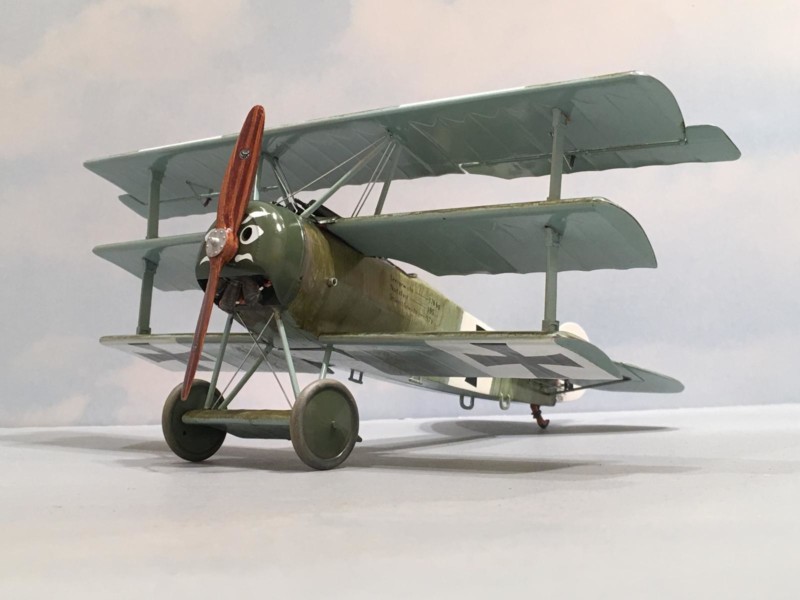
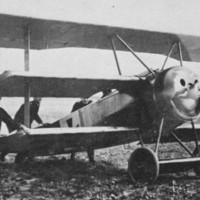
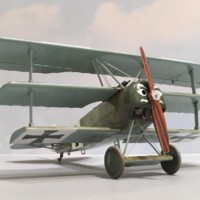
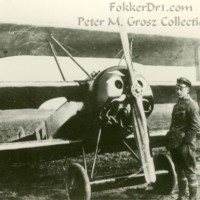
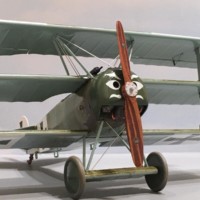
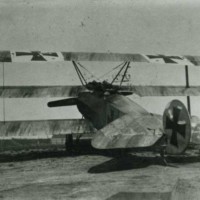
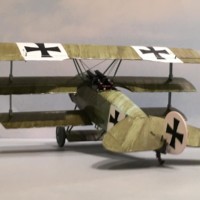
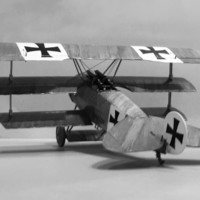
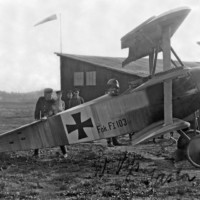
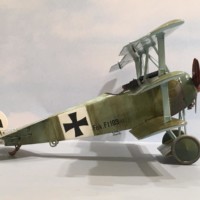
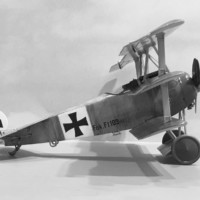
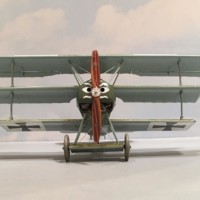
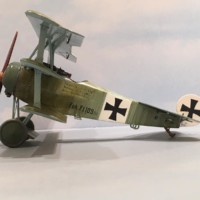
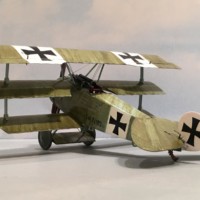
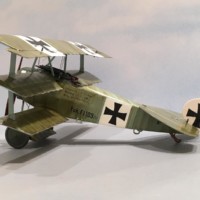
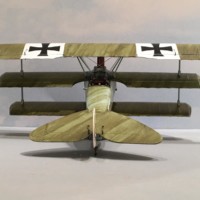

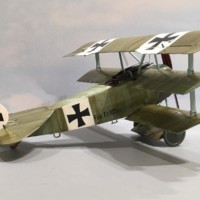
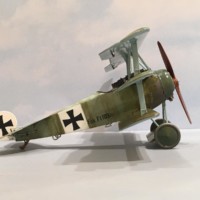
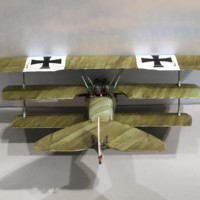
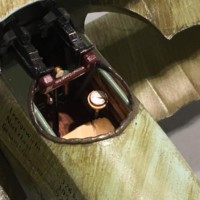
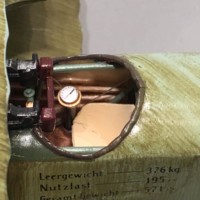
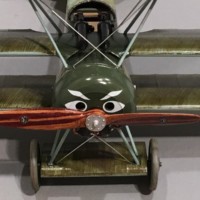
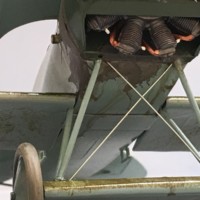
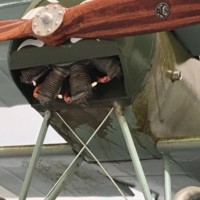
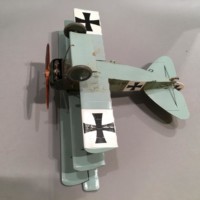
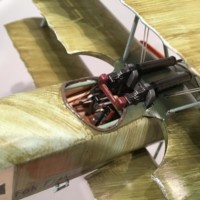
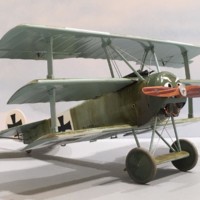
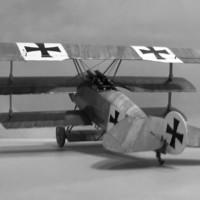
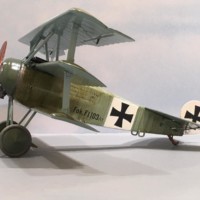
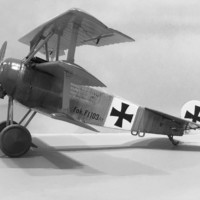
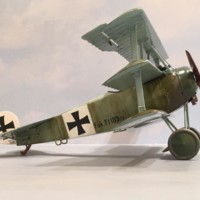
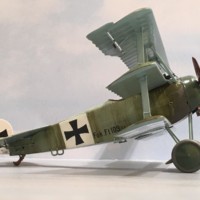
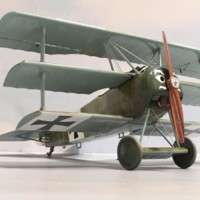
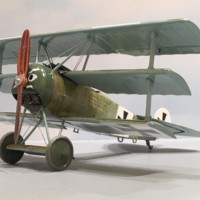
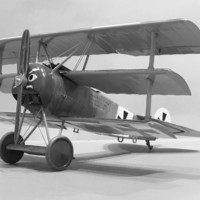
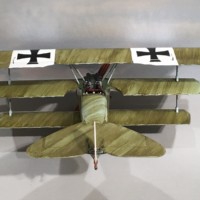
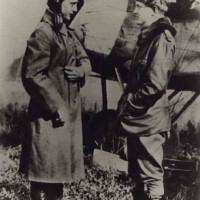
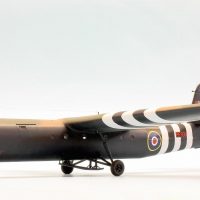
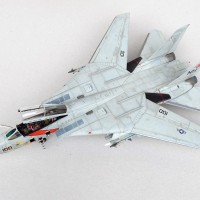
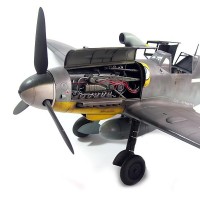

Great to see you posting again, Louis, and equally great to see the finished model here, as always, your enthusiasm and interest in the prototype show through in your detailed build and presentation. Weird scale though.
Thanks George. Things have been rather "hectic" around here lately to say the least... Hopefully they are returning to normal now.
As far as the scale goes, yes it's a rather odd size. But Revell molded 4 (I think) planes that were all in this scale. The Fokker Dr-1 and D-7, a S.P.A.D. 13 and a Sopwith Camel if memory serves me. There may have been others, but I'm not sure. These are the ones that I remember building as a child.
Thanks for the compliments my friend and for "liking" the article as well.
I have 3 of the 4 completed in my "box of horrors." (These recently came out of 30 years in storage and didn't survive intact.) Dad built these back when they were fairly new but he never had the D-7. The 3 he built and the D-7 you listed are all I've ever heard about.
Beautiful! I've been looking forward to this "reveal." It may not have been finished by the anniversary of his death, but it was worth waiting for.
You couldn't do anything about the weather, my friend. Trying & hoping to change the weather is about as possible as herding cats.
But it's shiney. And outstanding! Good on ya, Louis!
Thanks Jeff. I figured that you would like this one, especially since Voss was an old "Cavalryman" like you and I were 🙂 🙂 🙂 but we didn't get to fly... too bad.
Herding Cats, that's a good one, and very true. Thanks for the compliments and for "liking" the article as well. Take care buddy.
Thanks again...
I've "flown" in a tank ... but not very high or very far! HaHaHaHa!
Voss was one of my earliest "heroes" ... long before I was a Cav soldier.
She's a beauty, Louis! Good to see you back!
Thanks buddy ! It's great to be back here.
and thanks for "liking" the article as well...
What's not to "like", my friend... the build, the finish, the photography - everything! Beautiful all-around post as usual. Great job, neighbor.
Thanks for the compliments Craig ! It's good to hear from you neighbor... and thanks for "liking" the article too.
Lou, knowing what you've faced, this is a labor of love for your fellow modelers and extremely well met. I love these old 1/28 WW1 biplanes, as both my grandfathers served in the Great War.
Good work, friend, and keep 'em coming!
Thanks David, I appreciate the kind words. Yes, for me, building models and doing historical research is a labor of love. Like you, I really like these old Revell 1/28 planes... I had several distant relatives that served in the "Great War" too. American "dough boys" in the trenches... I am very pleased to see that you have also "liked" the article as well.
Take care my friend. And please keep in touch.
Well done Louis , I think you’ve captured Voss’s aircraft. Great backstory too. I seem to remember during the course of the final fight that he used thr Dr 1’s superior climb performance to break out of the melee only to turn and dive back into the fight, and that the RFC pilots said he could have broken off the engagement at will simply by climbing away. Makes one wonder if combat fatigue was clouding his judgement that day. I like the way you’ve tried to stage you photos to match war time pictures very moody to steal a phrase. What’s the next build that’s trying to escape your fevered brain bucket lol
Thanks Rick ! I appreciate the support along the way during the build log.
Yes I read that too about the Fokker's ability to climb better than the S.E. 5's he was up against that day... But then I uncovered a little bit of information that is often not mentioned.
It appears that there was another flight of SE's flying above them. I think it was called "C" flight. They were acting as top cover... So had Voss climbed away he would have simply ran into them. It's my personal opinion that he saw the SE's flying above him there, and thought it would be best to stay where he was at taking his chances where he knew his plane had the edge in maneuverability... Just my thoughts and not set in stone.
I thought it would be pretty cool to try and show how the model looked in B & W photos. So I experimented by posting a few pictures I took using the gray scale.
The next build hasn't really been decided 100 % just yet. I have a few on the work bench that I need to finish first.
Take care my friend.
Certainly good to see you worship in the proper Church of the Olive Green Cowl and White Rudder! 🙂
Also good to see you got the proper horizontal stabilizer with the curved leading edge.
Very nice result!
Thanks Tom.
Besides the stabilizer, there were some alterations made to the cowling and I removed the lower wing tip skids as well. Here Paul Nash was of great help since he provided some engineering diagrams on the cowling.
After looking at various original B&W photos, plus reading that his two mechanics stated that the plane wasn't painted with yellow, I decided against it.
Thanks again.
Absolutely stunning Louis, congratulations! What a peach of a build - certainly one of my favourites this year. Thanks for the story and the inspiration, as ever!
I am very pleased to hear that this build was an inspiration to you. I'm also stoked to hear this is one of your favorites this year. There's not a better compliment than that ! 🙂 🙂 🙂 You just made my day buddy... Thanks my friend.
Louis, this is really nice, you've really captured a very realistic look on this one. I also enjoyed the story. Well done !
Hello Terry ! Good to hear from you. I'm going to post an article in a few minutes on how I did the Fokker streaks. I'm also very pleased to see that you not only enjoyed the story, but that you have "liked" the article as well. Thanks for the compliments Sir. Take care.
Louis - It's great to see another realistic Dreidecker, especially F 103/17 which Voss made such a memorable mount. As you know, I've kept pace with your build and the finished article and your presentation here do you great credit. Well done. I've got a Revell 1/28 Camel lurking in a cupboard which one day I'll have the courage to modernise. Did you ever read "September Evening" by Barry Diggens (Grub Street ISBN 1 904010 47 4)? A great and detailed story of Werner and his military exploits, particularly for the Voss followers. Keep'em coming and well done!
Paul
Hey Paul,
No I haven't read the book you mentioned, but I may end up getting a copy of it soon. Voss is one of my all time favorite WW1 flying Aces. This one would not have turned out as realistic without your assistance with providing the subtle (and not so subtle) differences between the three "pre production" machines and a standard Dr-1. These little attention to detail things make all the difference, and I sincerely appreciate the efforts you put forth with helping to guide me during the construction of this plane.
Thanks for the compliments, and I plan on posting an article in a few about how I did the "Fokker Streaks" . Hopefully this will help someone along the way with their future Fokker builds. This will be sort of like helping out the modelling community like you did with me during this build.
I'll keep an eye out for the book you mentioned, and thanks again for everything you did to help with this one along the way. Please keep in touch my friend.
Very nice, Louis. Revell’s interesting (if unusual) scale adds that little extra in terms of display presence.
Thank you Rob for the compliments. I agree that Revell's 1/28 scale size was rather odd, but like you stated, it makes the model a tad bit larger than one of the same plane in the customary 1/32 size that we are used to. I am also very pleased to see that you have "liked" the article as well. Take care my friend.
Very nice job, it is beautiful.
Congratulations, Eric from France
Thanks for the compliments and for "liking" the article too !
Wonderful story and a great build. Always teach something to watch how people as talented as you build models.
Thanks for the compliments, but I feel there are many builders out there who are much better than I am. Thanks for "liking" the article, and I'm glad you enjoyed the story too.
An excellent build, Louis!. My Dad's favorite plane and pilot. There were just the four kits you mentioned, the D7 being the late arrival, somewhere in the eighties I think.
Thanks Robert ! You're correct about the D7 coming in later. I built mine in the mid 1990's... But it had been released previously. Voss is one of my all time favorites too...
Gorgeous build Louis! Seems like you really captured the aircraft.
Thanks Greg !
Very good job, Ilike the way you paint the Fokker linen, and the compare between your black and white pics and the real bird.
Thank you Roberto. I'm going to post an article on how I did the "Fokker Streaks" in a few... I thought the B & W pics were pretty neat too. Thanks for liking the article too.
OK, Louis: where are you going to get a Voss figure to go in the cockpit? That way your black & white photos will look even MORE like the real photo!
It really would be cool if there were some "famous" pilot figures could be found in 1/28 scale.
Now that would be COOL 🙂 🙂 🙂
Hi Louis - Just noticed your thought about a Voss figure. Don't know where this comes from but I'm sure I've seen a kit waaaaaayback of F1 with a Voss figure as part of the package. I'm half convincing myself it may have been a special Revell 1:28 scale edition but that might be wishful thinking. It may have been another manufacturer and scale of course. I've no idea if you could find one, but the guys at Copper State Models seem to have a lot of experience with these kits so maybe it's worth asking them.
Cheers - Paul